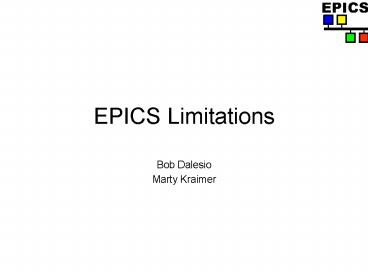EPICS Limitations - PowerPoint PPT Presentation
Title:
EPICS Limitations
Description:
Many people could and should add the limitations that they encounter to this. ... are at least two instances of data silo for getting synch data but not in the ... – PowerPoint PPT presentation
Number of Views:13
Avg rating:3.0/5.0
Title: EPICS Limitations
1
EPICS Limitations
- Bob Dalesio
- Marty Kraimer
2
Limited view point
- These slides are written from a limited
perspective - Many people could and should add the limitations
that they encounter to this. - It is a collaboration and that is an invitation
to voice what is wrong (and volunteer to fix some
of it)
3
There is no device abstraction in the database
- What are devices?
- Power Supplies w Magnets
- Scope
- What are the properties
- multiple inputs and commands
- states taking data, ramping, turning off
- multiple status bits over temp, on/off etc.
- Does each command and status become a channel
- Does the value / status fit the command / state
model - Does a device use channels for interfaces to hw
- Does a device disallow control of output channels
it use - Marty is working on a new database to overcome
this.
4
System Limitations
- The database can process as many as 100K records
per second in the new power PCs faster
processors. - But, the fastest response time to an interrupt is
on the order of 30 usecs for interrupt latency
and record processing - Distributed IOCs can run loops over Channel
Access at about 20 Hz, care must be taken to
handle loss of communication. - Faster applications must be done in dedicated
hardware (interface it to EPICS for integration
and expose all variables and configuration
parameters) - There is no way to add channels to a running IOC
without restarting it (redundant IOCs may limit
the impact)
5
Channel Access Limitations
- There are currently 2 versions of the Server
- There is no built in name introspection
- What to do about an interface to devices? a thin
interface supports general purpose / reusable
clients - Currently we can only monitor on value dead band,
alarm dead band, or change of alarm status. It
would be nice if we could monitor on - Frequency or dead band per client
- Monitor device when a certain state is true (BPMs
used for different virtual beam lines) - No support for synchronous gets from variety of
IOCs (there are at least two instances of data
silo for getting synch data but not in the
release of EPICS) - The support for arrays is weak
- The time base and offset are not in the array
data - There is no direct support for multi dimensional
arrays. - No support for subarrays in the protocol
- Arrays are not buffered only pointers to the
arrays are buffered - There is no support to direct the record to
process for a get or put this is decided
statically in the field description in the .dbd
file.
6
Database Limitations
- Only time stamp, display limits and control
limits meta data can be obtained. It would be
nice if some new metadata or data structures were
available - Statistical information
- Data from the past? Statistical data from the
past? - Message / State Data?
- Data to support device implementation
- There is weak support for process control
algorithms for PID and lead/lag control and no
control loop cascading support - The record set and record reference manual needs
to be updated. - Redundancy is supported in a limited way but
there is no fielded device support that takes
advantage of this capability.
7
Configuration tools are limited
- Reusable relational database tools for
configuration are nearly non-existent. - All configuration tools are done in stand alone
tools not in an integrated environment.
8
Clients
- Adherence to industrial standards for tools like
a state-transition tool - Integrated develop environment would be nice is
CSS becoming this? - Physics applications are not tightly integrated
with the control system and frequently these
tools recreate functionality that is ready in
other client tools. - Web based technology is not available in a
uniform way.
9
Conclusions
- Our community has successfully delivered control
systems for a number of applications. - The ability to share software and hardware
solutions is enhanced by working on the same base
even though it is flawed. - The architecture supports the ability to create
work-arounds. - There is always work that can be done to improve
productivity and reliability while reducing
costs. - The community should actively inform us when
things are not working or if you have a better
solution that we could use.































